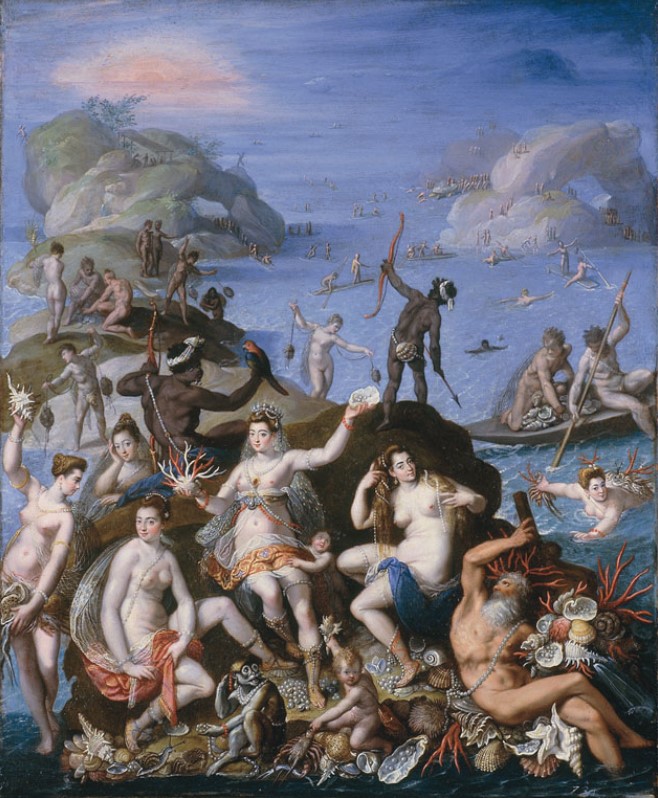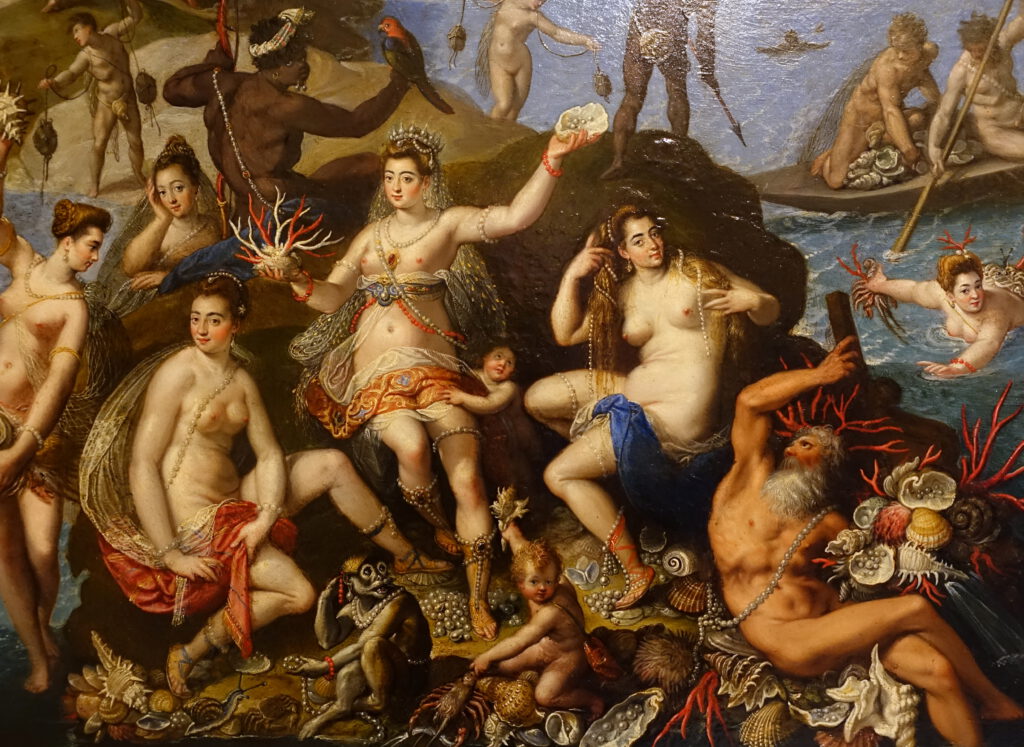Patricio Flores Silva- Department of Sociology, University of Warwick.
After discovering ‘the new world’, European conquerors felt deeply impressed by its natural richness. Given the majesty of its forests, the unlimited fruits provided by its trees, the fertility of its virgin valleys, the Americas, in general, and South America, in particular, were assumed as living representations of the ‘Promised Land’, a land where human beings would be able, among other things, to live without having to compete with each other for those resources necessary for their survival. Before the Americas’ discovery, the paradise, the place where human beings would live peacefully and without feeling fear because of unsatisfied needs, was not here, in this life, in this world; rather, it was outside the Earth and beyond this life, in a heavenly realm which was exclusively open for good will men. But after the Americas’ discovery, the paradise, represented, for instance, in paintings like Allegoria della scoperta d’América (1585), seemed to be here, in this world, and, if you were brave enough to make the long journey through unknown routes, you could enjoy it in this life. ‘America was there, within hand’s reach, to take advantage of it’ (Sanfuentes, 2006).

Image 1: Allegoria della scoperta d’América, by Jacopo Zucchi (Source: https://galleriaborghese.beniculturali.it/opere/allegoria-della-scoperta-damerica/)
However, before starting to occupy the New World, conquerors had to deal with a big problem: the Americas were inhabited by indigenous peoples. Besides having a different physical appearance, indigenous did not speak conquerors’ language, they did not dress like them, they did not have their cities, and, to make matters worse, they did not know the Christian god. As a result, they rapidly became viewed as savage and deplorable beings who needed to be, at best, civilized or, at worst, completely exterminated (though, for many Europeans, the last one was the best option really). In this context, the situation in the Americas started to turn into one of several civilizing and extermination campaigns, while, at the same time, their ancient territories were occupied by the newcomers, making the indigenous extermination even faster. In doing so, the Americas underwent a deep transformation in terms of its human and physical geography, with the emergence of coffee plantations, sugar-cane croplands, and mining camps, among other things, worked by slaves taken from black or indigenous communities to benefit white men from distant kingdoms.
Currently, the Americas, especially South America, are still a territory subject to deep socionatural transformations. But while in the colonial period these transformations were conducted by foreign imperial forces, today, they are led by national states linked to multinational corporations in order to reinforce the process of capital accumulation. In doing so, a place that, at the beginning, was approached as a promised land, almost as an earthly paradise, is today an area where nature has been restricted to national parks to allow the rising of mine tailings dams, massive petrochemical complexes, sacrifice zones, etc. In brief, and as Eduardo Galeano (2008) said, South America, and the Global South in general, is a region of open veins, a territory that bleeds through heavily polluted rivers, people suffocated by toxic atmospheric emissions, forests and mountains completely destroyed as a result of extractive industries, among other things.
The current issue of Toxic News is an invitation to explore those ‘open veins’ and how people from the continent try to seek hope amid increasing environmental violence. The issue begins with the article “The air feels bad”, written by Efren Legaspi, an inhabitant from the Quintero/Puchuncavi bay, where the Chilean state established the biggest industrial complex of the country. Through this contribution, Legaspi reflects on the experience of living in the middle of a sacrifice zone, emphasizing how the toxicity is ‘invisibilised’ by state and corporate agents and how people try to reveal the presence of toxins in their daily life.
Similarly, Mauricio Berger and Cecilia Carrizo reflect on the pollution caused by agrotoxics in Córdoba, Argentina, focusing on the struggles of ‘pulverized communities’ -people affected by fumigation activities- to be recognized as victims by the Argentine State. Specifically, they show us how an environmental controversy turns into an epistemic dispute, a dispute where the claims posed by the affected ones are constantly challenged and dismissed by state and corporate actors. In doing so, like Legaspi, they invite us to approach toxicity by leaving aside narrow perspectives which focus only on the effects of particular substances on the human body, to include the role played by corporations and states in enabling toxic encounters between chemical substances and certain groups of people defined as “pollutable”.
Following this, Daniel Renfrew leads us to Uruguay, where a massive lead poisoning was discovered in 2001. Based on his recently published book Life without Lead: Contamination, Crisis, and Hope in Uruguay, Renfrew comments on the trajectory followed by inhabitants of La Teja, a working-class neighbourhood located in Montevideo, to turn a silent problem into a public problem which required state intervention. Again, here we can see the efforts of affected people to make visible an invisible crisis, and although in this case they were able to mobilize the State according to their demands, Renfrew shows us how the very same state intervention led to pathologizing and stigmatizing an already-dispossessed community. In this sense, this contribution suggests that the search for environmental justice does not imply absolute triumphs; paradoxically, attaining justice implies dealing with small or subtle kinds of injustice.
Subsequently, Eliana Creado shares with us a photo-essay based on her fieldwork in a Brazilian zone affected by the collapse of two massive mine tailings dams in Bento Rodrigues (Mariana, Minas Gerais), the worst ever environmental disaster recorded in the history of Brazil. In this contribution, she explores the toxic legacy left behind by a tailings spill, emphasizing how, instead of being an isolated accident, it triggered a continuous disaster whose consequences have changed an entire geographical area. But, more interestingly, Creado’s contribution reveals one of the most prominent paradoxes of our current epoch, namely: how landscapes profoundly transformed by human activities ends up easily escaping from any form of human control, fostering disasters which have unpredictable consequences.
Finally, Ruth Goldstein comments on the problems faced by indigenous communities in Peru because of the massive usage of mercury in extractive activities. But, at the same time, her contribution is a story of hope, a story which shows the path followed by indigenous leaders to the Third Meeting of the Conference of the Parties to the Minamata Convention on Mercury (COP3), which took place in November 2019 in Switzerland, where they were able to expose their situation, placing, hopefully, the cornerstone for future actions to be adopted on this problem.
In brief, South America is still a region of ‘open veins’. But, as the struggles explored in each contribution reveal, it is also a terrain of hope, a terrain where, either through humble actions, like recovering pottery damaged by a wave of mine tailings, or through ambitious strategies, like denouncing environmental problems in transnational instances, people are trying to do something to find an alternative to an environmental crisis which, because of its global scope, no longer is a ‘Third-World problem’.
References
Galeano, E. (2008). Las Venas Abiertas de Latinoamerica. Madrid: Siglo XXI Editores.
Sanfuentes, O. (2006). Europa y su Percepción del Nuevo Mundo a Través de las Especies Comestibles y los Espacios Americanos en el Siglo XVI. Historia, 2(39), 531-556. doi:10.4067/S0717-71942006000200006
